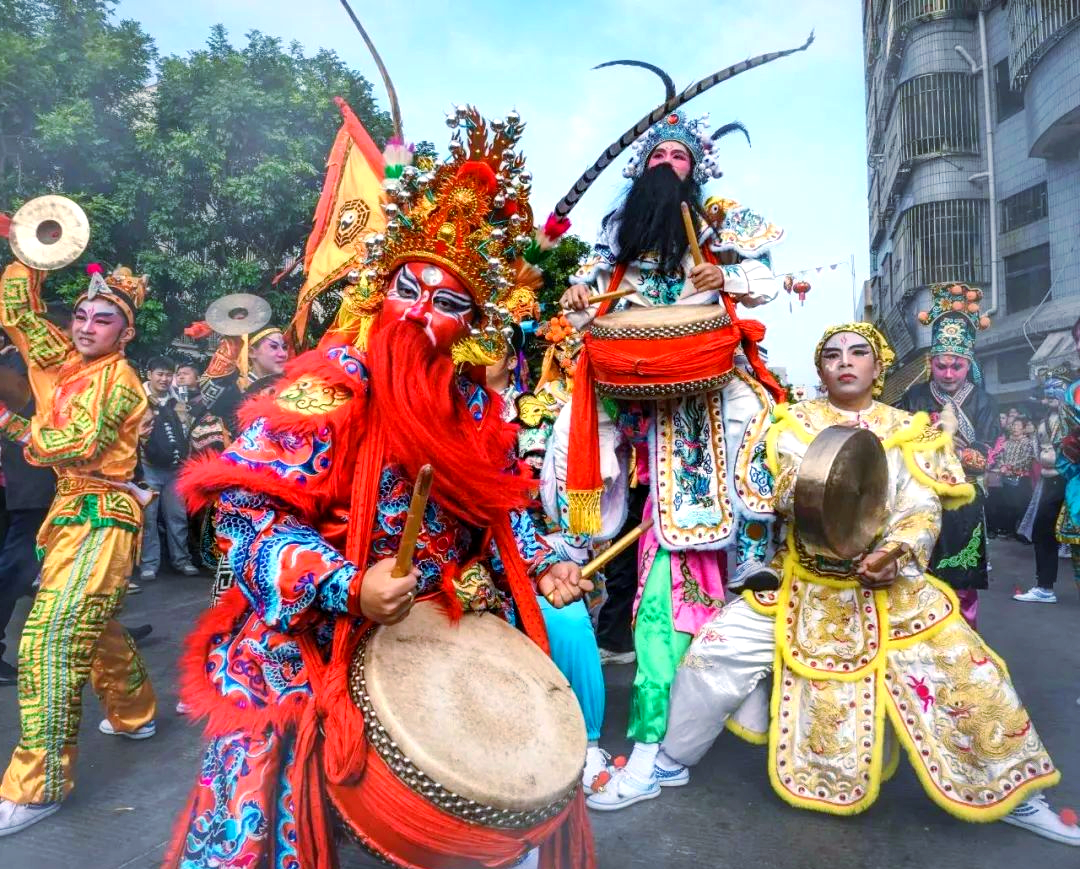Chaoshan Yingge Dance
The Chaoshan Yingge Dance features spectacular performances with dancers wearing traditional costumes, vivid facial makeup, and powerful movements
The Chaoshan Yingge Dance features spectacular performances with dancers wearing traditional costumes, vivid facial makeup, and powerful movements
Chaoshan Yingge Dance is a large-scale folk group dance popular in the Chaoshan region of Guangdong Province. Combining drama, dance, and martial arts, it is renowned for its powerful movements, colorful facial makeup, and spectacular scenes. Referred to as "the most masculine folk dance of the Han Chinese," it was included in the first batch of national intangible cultural heritage list in 2006.
The origins of Yingge Dance can be traced back to the mid to late Ming Dynasty. There are several theories about its origins: one suggests it was created to commemorate the national hero Yue Fei; another connects it to the story of the heroes from "Water Margin"大闹Damingfu during the Lantern Festival; yet another theory believes it evolved from ancient Nuo dance, used to exorcise evil spirits and bring good fortune.
Yingge Dance integrates the folk customs, martial arts culture, and theatrical elements of the Chaoshan region. It preserves the ceremonial functions of ancient Nuo dance while incorporating folk entertainment and hero worship, becoming an important symbol and carrier of Chaoshan culture.
"Yingge Dance is a living fossil of Chaoshan culture. It carries the historical memories, values, and aesthetic tastes of the Chaoshan people and is an important part of their spiritual homeland."
Yingge Dance is world-famous for its unique artistic charm and distinctive local features. Its main performance characteristics include:

Yingge Dance performers wear colorful traditional costumes, holding double sticks, with powerful and energetic movements
Yingge Dance mainly features heroic characters from "Water Margin," typically including the head槌 (Qin Ming), second槌 (Li Kui), third槌 (Lu Zhishen), and other Liangshan heroes. Performers wear colorful traditional costumes, various helmets, and exaggerated facial makeup, creating a威武 and majestic image.
Yingge Dance movements are characterized by strength, power, and uniformity. They mainly include "8"-shaped steps, kicks, jumps, and turns. Dancers hold double sticks, performing while striking them, producing crisp and loud sounds that create a strong sense of rhythm and visual impact.
The accompanying music of Yingge Dance mainly consists of folk instruments such as drums, gongs, and suona horns, with bright rhythms and majestic momentum. Common pieces include "Great Opening" and "General's Order." The music closely coordinates with the dance movements, enhancing the appeal of the performance.
Due to regional differences and performance styles, Yingge Dance in the Chaoshan region has formed several schools, with the most representative being:
Yingge Dance is not only an artistic performance form but also has multiple social functions and cultural values:
Yingge Dance inherits the historical culture, folk customs, and aesthetic concepts of the Chaoshan region, serving as an important carrier of Chaoshan culture.
Yingge Dance performances require the participation of many people, promoting communication and cooperation among community members and strengthening community cohesion.
Performed during traditional festivals and celebrations, Yingge Dance embodies people's yearning for a better life and prayers for good fortune and happiness.
As a representative of Chaoshan culture, Yingge Dance has been performed many times at home and abroad, promoting cultural exchanges between China and foreign countries.
With the development of the times, Yingge Dance faces challenges in inheritance and development. To protect this precious intangible cultural heritage, the Chaoshan region has taken a series of measures:
In 2006, Chaoshan Yingge Dance was included in the first batch of national intangible cultural heritage list, receiving attention and protection at the national level. Local governments have increased support for Yingge Dance, raising its popularity and influence through organizing Yingge Dance competitions, cultural festivals, and other activities.
At the same time, more young people are beginning to learn Yingge Dance, and a number of young Yingge teams are gradually growing, injecting new vitality into the inheritance of Yingge Dance. Many schools have also incorporated Yingge Dance into their curriculum, cultivating a group of reserve talents for Yingge Dance.
If you want to appreciate authentic Chaoshan Yingge Dance performances, here are some recommended times and places:
To help tourists better understand Yingge Dance, here are explanations of some commonly used Yingge Dance terms:
| Term | Explanation |
|---|---|
| 头槌 (Head Hammer) | The leader of the Yingge Dance team, usually playing the role of Qin Ming, responsible for directing the entire team's performance. |
| 二槌 (Second Hammer) | The deputy leader of the Yingge Dance team, usually playing the role of Li Kui, assisting the head hammer in directing the performance. |
| 双棒 (Double Sticks) | Performance props held by Yingge Dance performers, usually made of bamboo or wood, used for striking to produce sound. |
| 舞队 (Dance Team) | The basic unit of Yingge Dance performance, usually composed of dozens of people. |
| 阵法 (Formation) | Formation changes in Yingge Dance performances, such as "Eight Trigrams Formation" and "Plum Blossom Formation." |
If you want to experience the charm of Yingge Dance firsthand, here are some practical suggestions:
This is related to the Chaoshan people's admiration for loyalty and resistance against oppression. The heroic images in "Water Margin" align with these values and also reflect the people's yearning for justice.
The double sticks are not only performance props but also produce rhythms that unify movements. They also symbolize weapons for exorcising evil, as the sound of the sticks can scare away demons and bring peace and good fortune.
Traditional Yingge Dance emphasizes masculinity with powerful movements and was historically performed mainly by men. However, modern times have seen the emergence of women's Yingge Dance, showcasing different artistic styles.